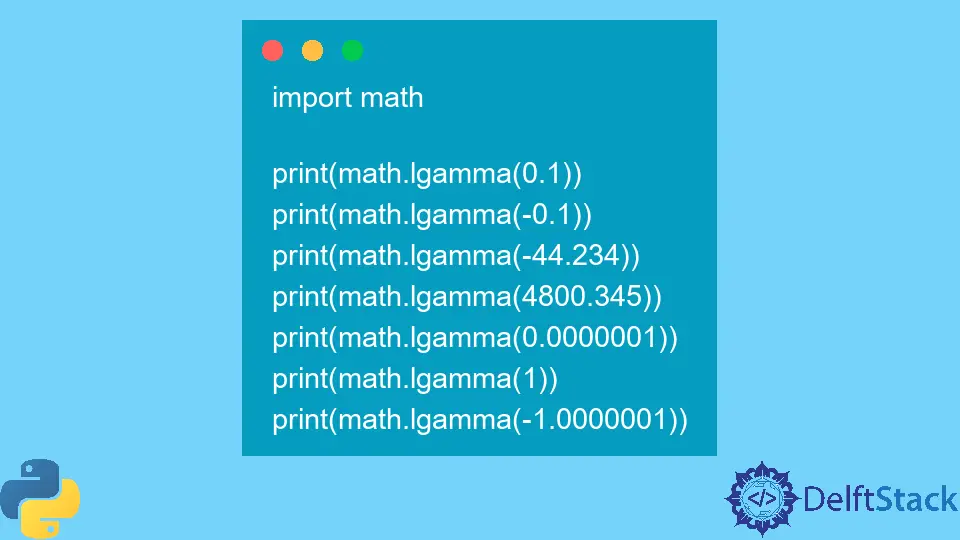Python math.lgamma() Method
- Syntax
-
Example 1: Use
math.lgamma()to Get the Natural Logarithm Gamma of a Number -
Example 2: Returns a
ValueErrorfor a Zero Value -
Example 3: Returns a
ValueErrorfor a Negative Integer Value -
Example 4: Returns a
TypeErrorfor a String Value

In Mathematics, the Gamma function extends the factorial function to complex numbers (a + bi) and non-negative integers. It is represented by the Greek alphabet Γ.

A natural logarithm refers to a logarithm at the base of a number’s mathematical constant e. Here, e is equal to 2.718281828459.

Python contains a built-in module, math, that enables us to easily perform a torrent of mathematical operations. It supports various mathematical operations and domains such as trigonometry and logarithms.
This module has procedures to perform the gamma function and natural logarithm, namely, math.gamma(x) and math.log(x).
The natural logarithm gamma value for a non-negative number is an amalgamation of two functions we talked about. We can perform this operation using the math.lgamma().

Syntax
math.lgamma(x)
Parameters
| Type | Description | |
|---|---|---|
x |
Float | A non-negative integer and non-zero value. Note that the value can be negative, but it should not be an integer. |
Return
The lgamma() method returns the natural logarithm for an absolute result of the gamma operation over a value.
Example 1: Use math.lgamma() to Get the Natural Logarithm Gamma of a Number
import math
print(math.lgamma(0.1))
print(math.lgamma(-0.1))
print(math.lgamma(-44.234))
print(math.lgamma(4800.345))
print(math.lgamma(0.0000001))
print(math.lgamma(1))
print(math.lgamma(-1.0000001))
Output:
2.2527126517342055
2.3689613327287886
-124.66184995040256
35886.18683992019
16.11809559323676
0.0
16.11809560809603
The Python code above computes the natural logarithm gamma value for 0.1, -0.1, -44.234, 4800.345, 0.0000001, 1, and -1.0000001. Note that these values are non-negative integers and non-zero.
If an out-of-domain value is offered to the lgamma() method, it raises a ValueError exception. Additionally, if the input is not a number, it raises a TypeError exception.
Example 2: Returns a ValueError for a Zero Value
import math
print(math.lgamma(0))
Output:
Traceback (most recent call last):
File "main.py", line 3, in <module>
print(math.lgamma(0))
ValueError: math domain error
Example 3: Returns a ValueError for a Negative Integer Value
import math
print(math.lgamma(-343))
Output:
Traceback (most recent call last):
File "main.py", line 3, in <module>
print(math.lgamma(-343))
ValueError: math domain error
The Python codes above show that the input for the lgamma() method can’t be a negative integer or a zero; hence, the method raises ValueError exceptions.
Example 4: Returns a TypeError for a String Value
import math
print(math.lgamma("this is a string!"))
Output:
Traceback (most recent call last):
File "main.py", line 3, in <module>
print(math.lgamma("this is a string!"))
TypeError: must be real number, not str
The Python code above takes a string as input; hence, the lgamma() method raises a TypeError exception.
